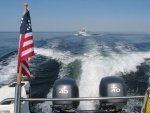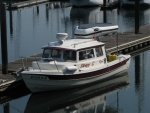Larry Patrick
New member
Put the boat in Erie in the rain Friday. First as I was putting up the bimini frame the forward piece that swings squashed my finger tip,probablly lose nail all black now. Second thing after wife backs me in water ,I start engine before launching ,she leaves steering not working correctly. Turn wheel 5xs the usual amount to get what usually is 1 time. Hard time turning around and getting to wet slip .When I get to my channel, steering stops all together,can spin the wheel same direction over and over. Wind is trying to blow me into rock jetty. Was ready to drop anchor ,but kept lowering and raising outboard turning wheel,finally a little steering and limped into slip.Talked with Anchor Marine and others ,no one can help till after Memorial day too busy. Called Marc Grove ,he told me to get some Telaflex oil .Took knob off and added oil at helm,turning wheel back and forth,seems like it worked. But inside wall of berth oil was dripping from round canister looking thing behind steering wheel. I see a gasket there looks like a lot of work to change it? I will try and tighten Allen screws, Hope that works. Wondering if boat is useable since dripping stopped and steering is working? Wonder if that's the high point and enough fluid remains in system to safely use? Next trip will start motor and turn it on and off for 15 minutes before going out,will have oil on hand. Appreciate any advise.



